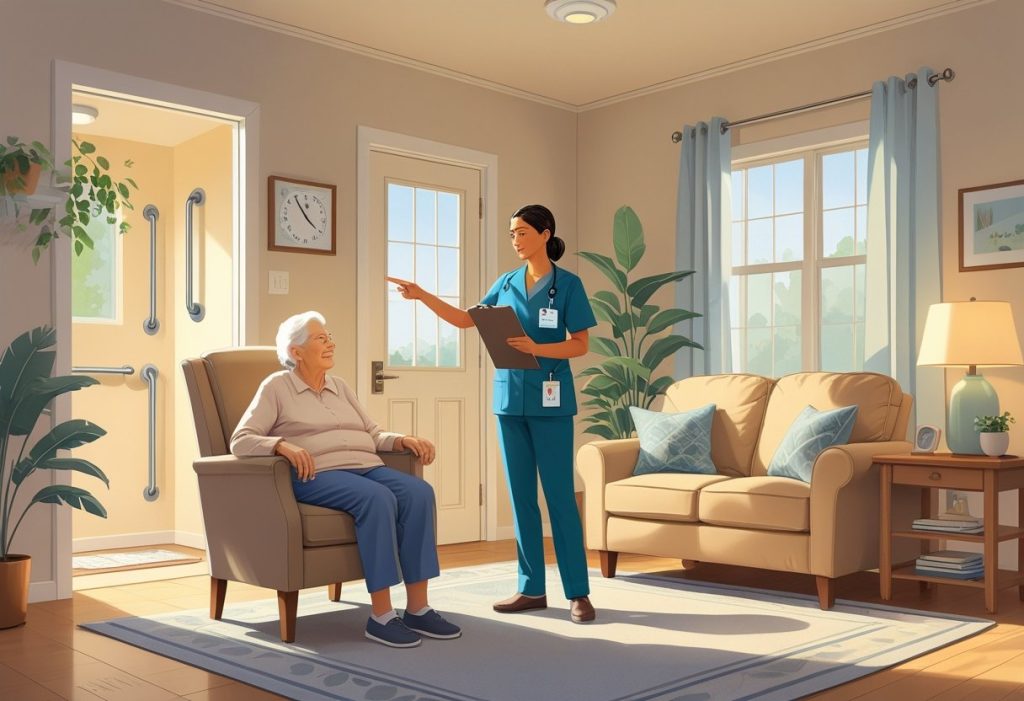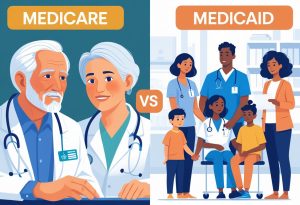As you navigate the complexities of Medicare, understanding the importance of a home safety evaluation can be crucial for your well-being. Medicare does cover home safety assessments as part of its services, provided your primary care physician orders it. This evaluation aims to identify potential hazards in your living environment, ensuring that you can remain safe and independent at home.
When considering your Medicare options, it’s beneficial to partner with a knowledgeable advocate. The Modern Medicare Agency specializes in helping you find Medicare packages tailored to your specific needs. Our licensed agents are available for one-on-one consultations, ensuring you receive personalized guidance without hidden fees.
Investing in a home safety evaluation not only helps prevent injuries but also enhances your quality of life. By taking this proactive step, you can feel more confident in your living space and make informed decisions about your health care coverage.
What Is a Medicare Home Safety Evaluation?
A Medicare home safety evaluation is a structured assessment designed to identify hazards in your living environment. It aims to enhance safety and well-being for older adults. This evaluation is distinct from general home safety assessments, focusing on Medicare beneficiaries and ensuring they can continue to receive necessary services.
Definition and Purpose
A Medicare home safety evaluation is conducted by licensed healthcare professionals, typically occupational or physical therapists. Its primary purpose is to assess your home for potential risks, such as uneven flooring or inadequate lighting.
The evaluation includes recommendations for modifications, such as installing grab bars or improving access to frequently used areas. By addressing these hazards, the evaluation helps you maintain independence and reduces the risk of falls and injuries. Medicare Part B covers this service when referred by your physician, ensuring you receive essential support.
Key Differences From General Home Safety Assessments
While both types of assessments aim to improve safety, Medicare home safety evaluations are specifically tailored for individuals enrolled in Medicare. Unlike general assessments, which may cater to anyone, this evaluation is focused on the unique needs of older adults under Medicare coverage.
Medicare evaluations often involve occupational therapists who understand the aging process and its impact on daily living. They can provide insights that general assessors may overlook. Additionally, these evaluations are designed to ensure compliance with Medicare requirements, enabling you to receive continued healthcare services without interruptions.
How Evaluations Improve Quality of Life
A Medicare home safety evaluation can significantly enhance your quality of life by fostering a safer living environment. Identifying and mitigating risks reduces the likelihood of accidents, allowing you to live with greater confidence and independence.
By implementing recommended modifications, such as improved lighting and accessible pathways, your home can become a more inviting space. These changes also support mobility, making it easier for you to engage in daily activities and reduce feelings of isolation. Ultimately, the evaluation is a step toward enhancing your overall well-being and maintaining your independence as you age.
For personalized Medicare insurance solutions, consider The Modern Medicare Agency. Our licensed agents work directly with you to find the best packages tailored to your needs, ensuring no extra fees hinder your coverage.
Who Performs a Home Safety Evaluation?
A home safety evaluation is typically conducted by qualified professionals trained to assess safety concerns for elderly individuals. These evaluations often involve an interdisciplinary approach, primarily incorporating occupational therapists and medical social workers, ensuring a comprehensive assessment of the home environment.
Occupational Therapist and Their Role
Occupational therapists (OTs) play a crucial role in home safety evaluations. They specialize in understanding how physical environments affect daily living activities. An OT will visit your home to assess potential hazards, such as clutter or inadequate lighting, and suggest modifications to enhance safety.
Their training enables them to recommend assistive devices that can help you maintain independence and reduce the risk of falls. Essential assessments may include evaluating your ability to navigate stairs or the bathroom safely. Therapists not only focus on physical factors but also consider cognitive aspects, ensuring a holistic approach to your safety.
Medical Social Worker Involvement
Medical social workers may also participate in home safety evaluations, although their focus differs slightly. They assess social determinants that may affect your safety at home. This can include evaluating relationships with caregivers or family members and identifying community resources that can offer support.
Social workers can address emotional and psychological factors that impact well-being. By ensuring you have access to necessary support networks, they help create a more secure living environment. Collaboration between social workers and other professionals contributes to a thorough understanding of your unique circumstances and needs.
Training and Certification Standards
Both occupational therapists and medical social workers must meet specific training and certification standards to perform home safety evaluations. OTs usually hold a master’s or doctoral degree in occupational therapy, along with state licensure and national certification.
Medical social workers typically require at least a master’s degree in social work (MSW) and must be licensed by their state. Continuous education is essential for both professions, ensuring they stay updated with best practices and evolving safety standards. This expertise is critical in identifying hazards and recommending effective interventions tailored to your individual situation.
Choosing the right professionals for your home safety evaluation can greatly impact your quality of life. With guidance from qualified individuals, you can confidently navigate your home environment while maintaining independence. The Modern Medicare Agency can guide you through insurance options to support these necessary evaluations, ensuring you have comprehensive coverage without unexpected expenses.
Eligibility and Medicare Coverage Details
Understanding the eligibility criteria and coverage details for Medicare home safety evaluations can help you navigate the process effectively. This section outlines key aspects of Medicare Part B, the Welcome to Medicare visit, and the roles of Medicare Advantage and supplement plans.
Medically Necessary Criteria
To qualify for a home safety evaluation under Medicare, it must be deemed medically necessary. Your primary care physician must determine that such an assessment is essential for managing your health. This evaluation is typically focused on reducing risks associated with falls and injuries at home.
Documentation proving the need for this evaluation should be submitted to Medicare. Depending on your specific case, other medical conditions may also influence eligibility. Ensure that you discuss your health status thoroughly with your doctor to facilitate a smooth approval process.
Coverage Under Medicare Part B
Medicare Part B covers home safety evaluations as long as they are ordered by your physician. This part of Medicare typically focuses on outpatient services, and home safety evaluations fall under this umbrella.
You may need to pay a deductible and coinsurance for covered services. This means that even if the evaluation is approved, you should be prepared for some out-of-pocket expenses. Contact The Modern Medicare Agency to gain insights on navigating these costs and maximizing your benefits effectively.
Welcome to Medicare Visit
During your first 12 months of Medicare Part B coverage, you are eligible for a Welcome to Medicare visit. This one-time appointment is crucial for assessing your overall health, which includes an opportunity to discuss the need for a home safety evaluation.
The welcome visit allows your healthcare provider to perform a health risk assessment and discuss necessary preventive services. Medicare typically covers this visit entirely, providing an excellent platform to initiate conversations about your safety evaluation needs.
Role of Medicare Advantage and Supplement Plans
Medicare Advantage plans may offer additional benefits that traditional Medicare does not. Some of these plans may include coverage for home safety evaluations without the out-of-pocket costs associated with traditional Medicare.
Additionally, Medicare Supplement plans can help you manage out-of-pocket costs related to home assessments. Consulting with a licensed agent from The Modern Medicare Agency can assist you in finding plans tailored to your needs, ensuring that you receive comprehensive coverage.
The support you receive from our agents can simplify the complexities of finding the right coverage, making it easier for you to focus on your health and safety.
What to Expect During a Home Safety Assessment
A home safety assessment is a proactive step to identify and mitigate potential hazards in your living environment. Understanding the details of this evaluation will help you prepare effectively and make necessary adjustments to enhance safety in your home.
Assessment Process Step by Step
During a home safety assessment, your healthcare provider will begin by discussing your specific concerns and health history. This conversation is crucial for addressing unique needs related to fall prevention and overall safety.
Next, the assessor will thoroughly inspect your home. This includes checking high-risk areas such as hallways, bathrooms, and kitchens. They will look for specific fall hazards, like loose rugs, poor lighting, and clutter. The assessment may also involve evaluating your mobility aids, such as walkers or canes, to ensure they are suitable and safely used within your space.
After the evaluation, you can expect a discussion about recommendations. These may involve modifications, such as installing grab bars or improving lighting. Understanding these suggestions empowers you to create a safer home environment.
Checklist of Common Hazards
Here are common hazards evaluated during the assessment:
- Loose Rugs: These can cause trips; securing them or removing them is advisable.
- Poor Lighting: Dimly lit areas increase fall risks; consider brighter bulbs or night lights.
- Cluttered Walkways: Keeping pathways clear prevents accidents; make it a habit to tidy regularly.
- Bathroom Safety: Make sure to have non-slip mats, grab bars, and accessible shower seats.
- Kitchen Layout: Ensure that items are within easy reach to avoid risky stretching or climbing.
This checklist can help you identify areas to address before the assessment even begins.
Duration and Report Outcomes
Typically, a home safety assessment lasts about 30 to 60 minutes, depending on the home’s size and the number of hazards identified. The assessor will pay special attention to areas and features critical for fall prevention.
After the evaluation, you’ll receive a report outlining findings and recommendations. This report will include specific actions to improve safety and reduce fall hazards. Follow-up consultations may also be available to discuss these recommendations in detail.
Choosing The Modern Medicare Agency means you benefit from personalized support throughout this process with licensed agents who engage with you one-on-one. They can help you navigate Medicare insurance options without hidden fees, ensuring you receive the best coverage tailored to your needs.
Core Safety Checks and Home Modification Recommendations
Ensuring your home is safe and accessible requires a thorough evaluation of potential hazards and necessary modifications. This includes identifying fall risks, addressing fire and electrical safety, and implementing essential home modifications.
Fall Hazard Identification and Solutions
Identifying fall hazards is crucial, especially for seniors. Common trip hazards include loose rugs, clutter, and uneven flooring. To mitigate these risks, consider installing handrails on both sides of staircases and adding non-slip mats in key areas like bathrooms and kitchens.
A thorough assessment should also examine bathroom safety. Installing grab bars near showers and toilets can provide additional support. Ensure that all pathways are clear and well-lit, and consider using a medical alert device for emergencies.
Fire and Electrical Safety
Fire safety begins with the installation of smoke detectors and carbon monoxide detectors in key areas of your home. Replace batteries regularly and ensure that detectors function effectively. It’s advisable to keep a fire extinguisher accessible in the kitchen and living areas.
In terms of electrical safety, check for frayed wires and overloaded outlets. Use grounded outlets for major appliances. Consider having a professional inspect your electrical system periodically to prevent fire hazards.
Essential Home Modifications
Making necessary home modifications enhances safety and convenience. Widening doorways and ensuring wheelchair accessibility can significantly improve mobility. Installing grab bars and using non-slip flooring can substantially reduce fall risk.
You may also want to consider modernizing your lighting fixtures. Bright, adjustable lighting can help prevent accidents. Lastly, engage with a representative from The Modern Medicare Agency to explore coverage options for home modifications essential for safety and well-being. Our licensed agents provide personalized assistance tailored to your needs, ensuring you receive valuable Medicare Insurance guidance without excessive fees.
Costs and Resources for Home Safety Evaluations
Evaluating the costs associated with home safety assessments can help you make informed decisions about your care options. Understanding the potential out-of-pocket expenses and available community resources is crucial for effective planning.
Typical Assessment Costs
The cost for a home safety assessment generally ranges from $199 to $399. Factors affecting this cost include the size of your home and the complexity of the assessment required. Medicare Part B may cover these expenses if deemed medically necessary by your primary care physician. For detailed information about coverage, consult resources such as the Centers for Disease Control and Prevention or organizations like the National Council on Aging, which provide guidelines on safety evaluations.
Out-of-Pocket Expenses
If Medicare does not cover the full cost, you may need to consider out-of-pocket expenses. Typically, costs will include fees paid directly to an occupational or physical therapist performing the assessment. If the evaluation is part of your Welcome to Medicare visit, this could be covered entirely with no additional costs to you. Be sure to check with your provider regarding specifics and inquire about possible financial assistance programs.
Community and Non-Profit Support
Community resources and non-profit organizations can provide additional support for home safety evaluations. Look for local agencies that focus on seniors’ health and safety, as they often offer free or low-cost assessments. Organizations like the National Council on Aging can guide you to community resources. Partnering with The Modern Medicare Agency also gives you access to licensed agents who can assist you in identifying financial resources tailored to your Medicare needs, all without hidden fees.
Frequently Asked Questions
This section addresses common inquiries regarding home safety evaluations for the elderly. You will find specific answers about what these assessments include, how to obtain one, their cost, and the process involved in conducting them.
What is typically included in a home safety assessment for the elderly?
A home safety assessment typically includes identifying areas that may pose risks for falls or accidents. Common evaluations assess lighting, flooring, and furniture placement. Recommendations may be provided for modifications to enhance safety, such as adding grab bars or improving accessibility.
How can one obtain a home safety assessment for seniors?
To obtain a home safety assessment, you can contact a healthcare provider or an occupational therapist. They will evaluate your needs and recommend an assessment. Additionally, some organizations offer resources or referral services specifically for seniors seeking home safety evaluations.
Are home safety evaluations covered by Medicare?
Yes, home safety evaluations can be covered by Medicare. Specifically, Medicare Part B may cover these assessments if ordered by your primary care physician. It’s important to verify eligibility and coverage details with your healthcare provider.
What are the costs associated with a professional home safety assessment for the elderly?
Costs for a professional home safety assessment can vary based on location and the complexity of the evaluation. Generally, these assessments may range from $100 to $300. Checking with local providers or your Medicare plan can give you a clearer picture.
How does an occupational therapist conduct a home safety evaluation?
An occupational therapist conducts a home safety evaluation by visiting your residence and assessing various environmental factors. They observe your daily routines and identify any challenges you may face. Recommendations are tailored to enhance safety and independence in your home.
What tools are commonly used to perform home safety assessments?
Common tools used in home safety assessments include checklists that highlight potential hazards. Occupational therapists may also use simple measuring devices to evaluate spatial arrangements. Technology, such as voice recorders or handheld devices, can aid in documenting findings for better clarity and follow-up.
When it comes to your Medicare insurance needs, chose wisely. The Modern Medicare Agency offers licensed agents who are ready to assist you one-on-one. They help you navigate Medicare packages that suit your specific needs without unnecessary fees.






